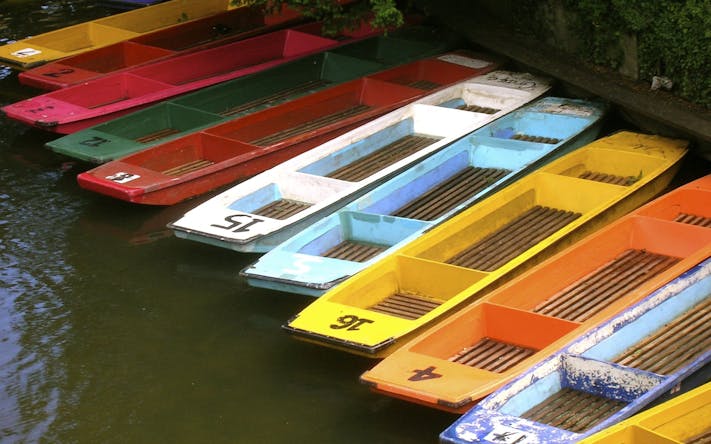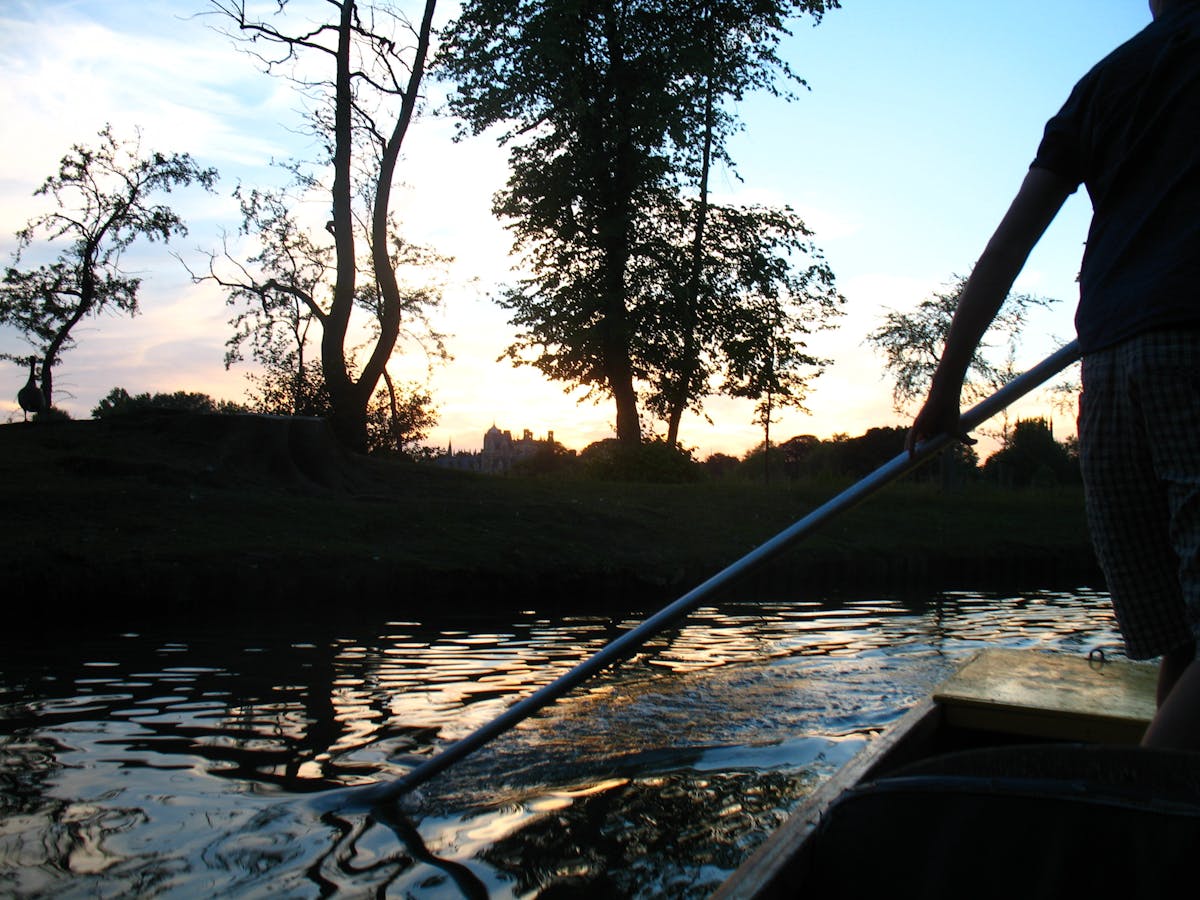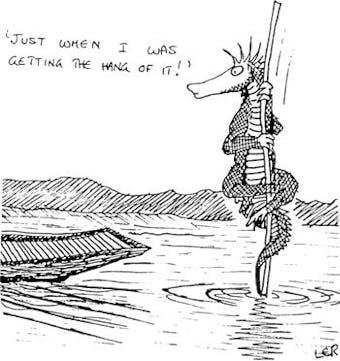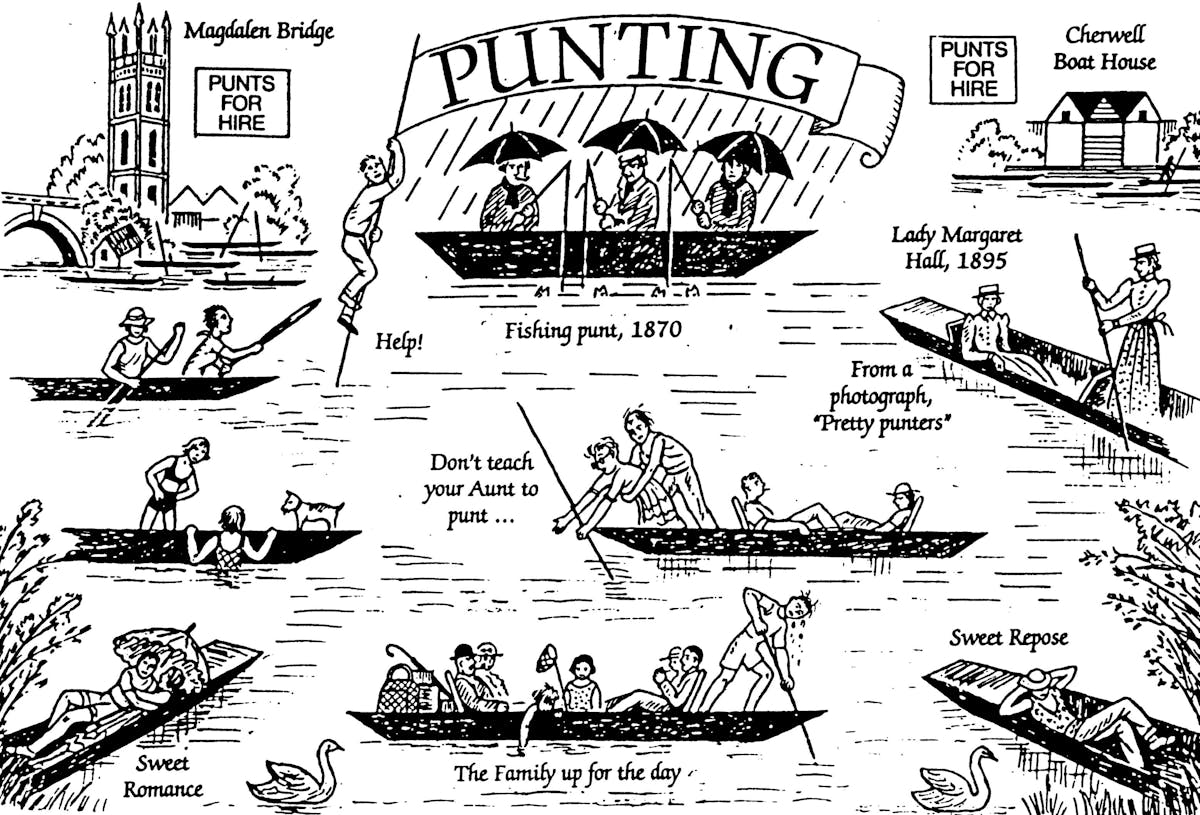
Who could visit – or live in – Oxford without trying their hand at punting? And who can predict whether they will be sublimely competent and capable of effortlessly avoiding all obstacles, or gloriously inept and incapable of keeping up with the speed of the stream? The following establishments will provide you with punts, advice if requested, and in some cases chauffeurs too.
Where to Get a Punt
Magdalen Bridge Boathouse
Punts (self-drive and chauffeured), rowing boats and pedalos. Float along the Cherwell past the Botanic Gardens, around Magdalen College School playing fields and Angel & Greyhound meadows, past St Hilda's, and up the recently cleared byways past Christ Church meadow to the Isis if you feel so inspired!
Open: daily, February-November, 9.30am to dusk.
Cost: £30/hour; chauffeur is £40/half-hour.
Magdalen Bridge Boathouse, High St, Oxford OX1 4AU. Map.
Tel: 01865 202643
Cherwell Boathouse
Punting, rowing, or Canadian canoes (also refreshments & restaurant). Float along the Cherwell past University Parks and Parson's Pleasure (downstream), or past Wolfson College and Marston meadows to the Victoria Arms pub (upstream). Chauffered punts available (minimum 2 week's notice).
Open: daily mid-March to mid-October, 10am-dusk.
Cost: £22/hour/£110 whole day weekdays, £24/hour/£120 whole day weekends & public holidays. Deposit: £110 weekdays/£120 weekends (hire-time deducted after visit). Cheques and cards accepted.
Cherwell Boathouse, Bardwell Road, Oxford OX2 6ST. Map.
Tel: 01865 515978
Oxford River Cruises
The only passenger boat firm offering river journeys upstream of the city. No punt hire, but they have a selection of electric motor boats. Also skippered cruises, some with special themes and food, should you fancy it.
Open: daily, Easter - October.
Cost: varies. Check their website for details.
Oxford River Cruises, The Folly, 1 Folly Bridge, Oxford, OX1 4JU. Map.
Tel: 08452 269396 / 01865 987147
Salter's Steamers
Self-drive punts, rowing boats and electric motor boats. Meander along the Isis (Thames) past the college boat houses (avoiding college rowers), explore the byways past Christ Church Meadow, or downstream towards Iffley Village and the Isis Tavern. Non-motorised craft can also explore the Cherwell towards Magdalen bridge.
Open: Easter - early October (weather permitting), 10am-6pm weekdays, 10am-7pm weekends. Scheduled cruises from the same location. 40 minute round trips leave hourly from 11am-5pm (on the same seasonal, weather and availability-related basis as the other vessels). Oxford-Abingdon service leaves at 9.15am and 2.30pm (late May - mid Sept), taking 2 hrs one way and leaving Abingdon at 11.15am and 4.45pm for the respective return journeys. A return is £20.80 for adults, £11.70 for kids. Private charter of the big boats for parties is also possible, along with the hire of self-drive diesel day boats.
Cost: Punts / rowing boats: £25/hour, £75/half day or £125/full day. Deposit and ID required. Diesel day boats: £60-90/hour, £170-260/half day or £285-415/full day, depending on capacity. Deposit and ID required. Visa and Mastercard accepted.
Salter's Steamers, Folly Bridge, Oxford OX1 4LA. Map.
Tel: 01865 243421
Note that many colleges have their own punts (sometimes on hire), normally moored at Magdalen Bridge or Cherwell boathouse. These are are typically available at very low rates to members of the college and their friends. If you are a student or have any collegiate affiliation, this is definitely an avenue worth investigating.
Bear in mind when weighing up hire costs that your average punt holds 4-5 puntees plus one punter. 5 people is the maximum number that most boathouses will allow you to carry, but a punt can seat 6-7 in reasonable comfort.
How to Punt
The first step in learning to punt is to find a reasonably quiet place in which to do it. If you try and take off straight from the mooring place on your first try, you’ll not only have less room to manoeuvre, but the captive audience at the punt-hire may proving disconcerting. Try getting a more experienced friend to punt you into midstream, and then have a go.
On Ends


Technique
Stand at the back of the punt, half-facing to the side (probably the right). Hold the pole vertically against the side of the punt (doesn't matter whether or not it's touching), and let it drop through your hands until it touches the riverbed. Swish or experienced punters throw the pole downwards, but we’ll save that for the advanced class. Push the pole downwards and backwards, gently at first, then more forcefully towards the end of the stroke (because, as your stroke “flattens” and the pole becomes closer to horizontal, less of your energy is going into pushing down into the riverbed, and more into pushing the punt forwards). For extra speed, bend your knees into the downstroke of the pole, so that you can get more push out of each stroke.
Try to push directly backwards, lest you swerve wildly to one side of the river. Let the pole trail behind the punt, acting as a rudder to guide the punt.
Now steer. You'll probably need to steer a little on each stroke. You do this by moving the trailing pole through the water to the side you wish the nose of the punt to point in (want the punt to veer left? Move the pole behind you to the left side). Be gentle: there is so little friction on the water that the punt will be continuing the swing long after you've forgotten about it and gone on to the next stroke.
Finally, retrieve the pole hand over hand, and return to start. If the pole gets stuck, give it a half-twist and a gentle tug to free it.
On Losing the Pole


You can remain clinging to the pole like a vertical sloth for quite a while. It will not be long enough. Whichever gives out first, your muscles or the substance holding the pole vertical, you are going to get wet. By this point, you have lost all semblance of dignity. Try at least to amuse the spectators (and there will be spectators) with a nice big splash.
As you progress with punting, you’ll probably find you won’t need to steer so much anymore, because you should be able to keep on course, and, if necessary, adjust direction simply by pushing slightly to one side or the other with the pole. When withdrawing the pole from the water, don’t swing it around to the side- pull it up and pass it through your hands. If you get stuck, don't panic, push away from the obstacle (getting your passengers to lend a hand or oar as necessary) and try again.
Some Things You Can Do In a Punt
Bridge-Hopping
Oxford has several splendid bridges, which can be observed from the vantage point of a punt (for a beautiful selection, including photographs, see here). Some adventurous souls, however, disdain mere idle observation, preferring a little danger, exercise and excitement with their punting (all those qualities normally absent from punting). Therefore, the "sport" of bridge-hopping was invented.
The idea of bridge-hopping is to stand on the deck of the punt, grab the bridge as it passes overhead, then climb across it as quickly as possible, ideally dropping down onto the punt as it passes out under the other side of the parapet. Bridge hopping can be hazardous (although it’s still safer than bridge-jumping), and frequently an ill-timed leap or a slippery bridge will leave the hopper soaked. Nonetheless, with small bridges, slow punts and a little common sense it's quite good fun.
Really adventurous bridge-hoppers will give the punt a good shove, then all grab hold of the bridge and attempt to climb over and jump into the punt on the other side before it floats away. They are sometimes to be seen traipsing muddily along the riverbank, hunting a fugitive punt.
Some bridges to try hopping: Magdalen Boy’s Schools and Magdalen College footbridges.
Some bridges not to hop: Magdalen Bridge, High Bridge.
Picnics
It is highly inadvisable to set off on a punting expedition without adequate provisions. The rivers of Oxford are deceptively easy to navigate, and many a punting party has found themselves lost for hours, with only ducks and hords of pedestrians for company. In such circumstances, a fortifying sandwich and glass of Pimm's are a necessary precaution (1 part Pimm's to 3 parts lemonade or dry ginger ale, mint, plenty of sliced fruit, minimum 1 apple, 1 orange, 1 cucumber & strawberries). As for what you exactly you should pack your hamper with, I'll leave that to a master to explain:
"That it will give a particular relish to success, if you be successful, and wonderfully dull the edge of disappointment, if the contrary be your fate, (which all good spirits avert,) if you never take punt (for we recommend that as the easiest mode of exercise) without stowing therein a sufficient basket of ham, tongue, veal pie, stilton-cheese, bottled ale and porter, port, sherry, moselle, claret, brandy, and cigars." - London Magazine, 1828
Plastic cutlery and glasses, napkins, a thermos of tea or coffee and some crisps are also a wise investment.
Races
Serious racing punts are a wonder to behold; unlike the lumbering monsters of pleasure punts, they are slim and fragile, holding two people (including the punter) at a stretch. In the hands of a skilled racer, they can achieve quite respectable speed, and a punt race (especially in narrow Oxford watercourses) is a sight to behold. Unfortunately, you're unlikely to have an opportunity to do so, but if you do, a proper punt race is performed along a stretch of water no shorter than 100 yards, and with a pole driven into the riverbed to mark start and finish. The race is one or more circuits, with each punt having to pass the finish pole, turn their punt, and return on the other side of the river.
Swimming


You may hear a lot about Leptospirosis, otherwise known as Weil’s Disease, an occasionally deeply unpleasant infection that can be spread via the urine of many mammals, chiefly rats. Cases of this are pretty rare in the UK (since the spirochetes that spread the infection can only live in temperate to warm conditions) but they have occurred. More realistically, a lot of rubbish gets chucked in the river, so follow some basic safety measures:
Either wear something on your feet, or don’t touch the bottom of the river. Getting a pair of old trainers soggy is a lot better than getting broken glass in your soles. Try not to swallow riverwater, and don’t swim if you have cuts or abraded skin. Most importantly, watch out for currents, especially near weirs or forks in the river. A few sad cases of drowning occur every year, and overenthusiastic swinging of punting poles won’t help. Just take usual precautions: watch out for hazards and be (or be near) a strong, sensible swimmer.
Punting Dos and Don'ts
DO:
Punt from the Oxford end (the shallow decked bit, rather than the obvious smooth raised platform). It's much less slippery that way and (more importantly) it's the Done Thing around here. We punt from the sloping end, while Cambridge falls off the flat bit.
Make sure you get a pole that floats. Wood is traditional but can be splintery, hollow aluminium is much better. Oxford tends to use aluminium, Cambridge wood.
Wear clothes that won't suffer if they get a bit damp and skanky, and footwear with grip.
Take account of the current when calculating your journey time to and from the boathouse.
Take suncream and/or umbrellas, and, vitally, a rubbish bag for the remains of your picnic.Watch out for low bridges and branches. They can come upon you very suddenly and with horrible inexorability.
Make yourself comfortable by bringing extra cushions and, if you're going out towards the end of the day, some insect repellent and a blanket or jumper (blankets are better than jumpers because they provide a legitimate reason for snuggling up to attractive seatmates).
Feed the ducks if you believe that ducks are messengers from another civilisation and that you will understand their speech if you listen just a little longer.
Read the authoritative guide to technique here.
Keep your centre of gravity low when you're moving around the punt.
If you are about to have a head-on collision, steer to the RIGHT.
DON'T:
Take delicate glass glasses. Plastic or paper cups or sturdy mugs are good. Imagine holding a small, energetic party in a bathtub for a few hours and you'll get an idea of the dangers.
Drink the river water. There's a certain amount of pollution and agricultural runoff in the Thames and Cherwell, as well as water rats who may or may not have Weils disease. The chances of your actually catching it, unless you get very intimate with an infected rat, are vanishingly small, but it is worth avoiding.
Dive in off the side of the punt. This can upset people and punts. There are also a lot of places along established punting routes in Oxford where the current is unexpectedly strong, and there have been fatalities of recent years, especially at high water.
Go down rollers between rivers with people in the punt. Results are likely to be expensive if not tragic.
Feed the ducks. Unless you want to be followed by ducks. And other waterfowl rising to swans. This is only delightful for the first hour.
Bring your mobile phone. Or if you must, stash it in a plastic bag somewhere out of the way.
Assume that anyone in any other vessel knows what on earth they're doing.

When punting through the University Parks it is usual for ladies to alight and walk round that part of the river known as Parson's Pleasure. This was traditionally reserved for nude bathing by male academics. There is a much-told story of a group of dons being startled by a puntload of ladies. They all rushed to cover the less acceptable parts of their anatomy with their hands - except one, who covered his face instead. In reply to the remonstrations of the others he said "I cannot answer for the rest of you, but I felt it important to cover that part of me by which I am most easily recognised."
See also:
Oxford Riverside Walks
Oxford's Open Spaces
Thames Guide A punter's guide to the Thames and Isis, the River Cherwell, and the Bullstake Stream, with history, pictures and poetry



